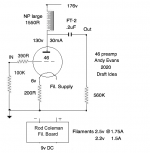Hello Bela - yes, indeed a 1:4 SUT is needed for most of these 2 stage designs. I think Thomas was using the Lundahl LL7903. It's what Ale uses and the one Per Lundahl recommends himself for this use. Not cheap though."Since the directly heated driver tubes have low gain, an input transformer steps up the voltage 1:4."
There are some posts on the thread "developing a 2a3 SET" about SUTs, including details of UTC and Hammond input transformers. I may re-post them here. I've ordered a pair of the Hammond 1140-LN-C 4:1 36K:2.2K, 10K:600
I came across a new transformer winder in Poland and here are the details - good prices.
UTM
https://utmindustry.com/ UTM Poland
UTM2546
2+2:1+1 €36.95 +30dbu
Impedance: 10k:2.4k, 10k:600Ω, 2.4k:2.4k, 2.4k:600
Primary Inductance: 70H+70H @100Hz
Secondary Inductance: 8H+8H @100Hz
Primary 240R Secondary 100R
Mu-Metal, High Nickel Core, 79% Nickel Steel lamination
UTM2581
tube input 1+1:2.5+2.5 €39.95 Primary 240R Secondary 100R +30dbu
Impedance: 1.2k:7.5k, 1.2k:1.8k, 600:1.8k, 600:15k
Primary Inductance: 2.2H+2.2H @100Hz
Secondary Inductance: 130H+130 @100Hz
Total DC Resistance PRI: 20Ω
Total DC Resistance SEC: 830Ω
Max Level: @50hz: +30 dBu
Mu-Metal, High Nickel Core, 79% Nickel Steel lamination
UTM2571
Ratio: (1+1)🙁1+1) +28 dBu €35.95
Impedance: 10k:10k, 10k:2.5k, 2.5k:2.5k, 2.5k:10k
Primary Inductance: 140H+140H @100Hz
Secondary Inductance: 140H+140H @100Hz
Total DC Resistance PRI: 330Ω+330Ω
Total DC Resistance SEC: 400Ω+400Ω
Mu-Metal, High Nickel Core, 79% Nickel Steel lamination
I came across a new transformer winder in Poland and here are the details - good prices.
Always happy to see a new winder discovery!
So it looks like models UTC2571, UTC2581 and UTC2582 would be the choices for gain at line levels? Low, medium or high gain models it seems, which would be the most useful for experimenting in this topic +11 db?
UTC2571 wirings:
UTC2581 wirings:
UTC2582 wirings:
Last edited:
Here is 1930 schematic of all-DHT 2- stage amplifier, the prevailing topology of the time. It is British, so used British tubes, but voltage stage is equivalent of 01A, and power stage could be something like 71, 45, or 50. Coupling is by interstage transformers. All-battery, including filament, bias, and plate supply.
The brochure is advertisement for interstage transformer, pretty advanced for its time.
The brochure is advertisement for interstage transformer, pretty advanced for its time.
Attachments
Visit their web site and sigh. Nobody will ever make a decent 10-15K SE interstage transformer allowing DC in primary.Hello Bela - yes, indeed a 1:4 SUT is needed for most of these 2 stage designs. I think Thomas was using the Lundahl LL7903. It's what Ale uses and the one Per Lundahl recommends himself for this use. Not cheap though.
There are some posts on the thread "developing a 2a3 SET" about SUTs, including details of UTC and Hammond input transformers. I may re-post them here. I've ordered a pair of the Hammond 1140-LN-C 4:1 36K:2.2K, 10K:600
I came across a new transformer winder in Poland and here are the details - good prices.
UTM
https://utmindustry.com/ UTM Poland
UTM2546
2+2:1+1 €36.95 +30dbu
Impedance: 10k:2.4k, 10k:600Ω, 2.4k:2.4k, 2.4k:600
Primary Inductance: 70H+70H @100Hz
Secondary Inductance: 8H+8H @100Hz
Primary 240R Secondary 100R
Mu-Metal, High Nickel Core, 79% Nickel Steel lamination
UTM2581
tube input 1+1:2.5+2.5 €39.95 Primary 240R Secondary 100R +30dbu
Impedance: 1.2k:7.5k, 1.2k:1.8k, 600:1.8k, 600:15k
Primary Inductance: 2.2H+2.2H @100Hz
Secondary Inductance: 130H+130 @100Hz
Total DC Resistance PRI: 20Ω
Total DC Resistance SEC: 830Ω
Max Level: @50hz: +30 dBu
Mu-Metal, High Nickel Core, 79% Nickel Steel lamination
UTM2571
Ratio: (1+1)🙁1+1) +28 dBu €35.95
Impedance: 10k:10k, 10k:2.5k, 2.5k:2.5k, 2.5k:10k
Primary Inductance: 140H+140H @100Hz
Secondary Inductance: 140H+140H @100Hz
Total DC Resistance PRI: 330Ω+330Ω
Total DC Resistance SEC: 400Ω+400Ω
Mu-Metal, High Nickel Core, 79% Nickel Steel lamination
OK Andy, here is mine from about 20 yrs ago. All 2V tubes, PP 33s, IT coupled to a triode connected 33 driver.So please post your ideas, schematics and comments of any kind and let's make this thread an interesting one!
And take your choice, triode or UL output. The 1B5/25S front end is a bit microphonic. Just another of my experimental amps.
And it sounds OK on my old RSC speakers from about 40 yrs ago. My ears don't care anymore.😀
Attachments
-
The 33 Amplifier.pdf661 KB · Views: 173
-
 Summary of Distortion Products 33 Amp at 2 Watts Single Tone.jpg132 KB · Views: 245
Summary of Distortion Products 33 Amp at 2 Watts Single Tone.jpg132 KB · Views: 245 -
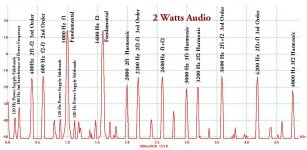 Summary of Distortion Products 33 Amp at 2 Watts Two Tone.jpg176.9 KB · Views: 170
Summary of Distortion Products 33 Amp at 2 Watts Two Tone.jpg176.9 KB · Views: 170 -
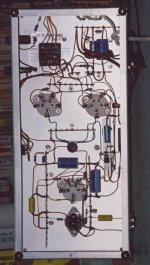 33AMP BOTTOM.jpg91.9 KB · Views: 189
33AMP BOTTOM.jpg91.9 KB · Views: 189 -
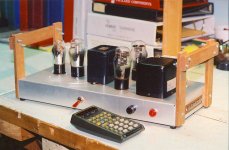 33AMP FRONTRHS.jpg89.4 KB · Views: 216
33AMP FRONTRHS.jpg89.4 KB · Views: 216 -
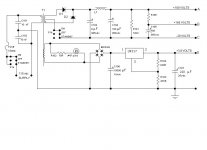 33 PP Amp Power Supply.jpg51.8 KB · Views: 279
33 PP Amp Power Supply.jpg51.8 KB · Views: 279 -
 33 PP Power Amp.jpg57.7 KB · Views: 269
33 PP Power Amp.jpg57.7 KB · Views: 269
I bought a DIY 26-300B amp designed by John Hogan 15 years ago and to this day I’m sorry I sold it.
It was a SET amp with the 26 tube driving the 300B output tube. Even though it is a SET amp, he used push-pull output transformers. It also had a knob to adjust hum to its lowest level.
Once the music was playing the hum couldn’t be heard.
Still the best amp I’ve ever heard.
It was a SET amp with the 26 tube driving the 300B output tube. Even though it is a SET amp, he used push-pull output transformers. It also had a knob to adjust hum to its lowest level.
Once the music was playing the hum couldn’t be heard.
Still the best amp I’ve ever heard.
DHT amplifiers were already getting old-fashioned in 1930, as indirectly heated valves appeared in the mid-1920's (1927 in Britain according to http://r-type.org/articles/art-002.htm ).Here is 1930 schematic of all-DHT 2- stage amplifier, the prevailing topology of the time. It is British, so used British tubes, but voltage stage is equivalent of 01A, and power stage could be something like 71, 45, or 50. Coupling is by interstage transformers. All-battery, including filament, bias, and plate supply.
The brochure is advertisement for interstage transformer, pretty advanced for its time.
That's piling on the euphonics! Two of the most lush and warm tubes in the DHT lineup.I bought a DIY 26-300B amp designed by John Hogan 15 years ago and to this day I’m sorry I sold it.
It was a SET amp with the 26 tube driving the 300B output tube.
Still the best amp I’ve ever heard.
I'm good with the 2a3 - more neutral and focussed. But many output tubes I haven't tried - mostly too rare/expensive like PX25.
Too rare/expensive ... as my beloved TT tubes: VT51/841, 10/10Y/801. 😉mostly too rare/expensive like PX25.
Let's not forget about large power DHT tubes: 807, 211.
They are a bit uncomfortable, need high voltage and high impedance OPT, but promise high/er/ power than "common" DHT power tubes.
It doesn't meet the requirements in the opening post, as the 12GN7A is indirectly heated and is used as an amplifier stage.
It doesn't meet the requirements in the opening post, as the 12GN7A is indirectly heated and is used as an amplifier stage.
Indeed - DHTs only here.
Member
Joined 2009
Paid Member
Nice calculator too, still my fav.OK Andy, here is mine from about 20 yrs ago. All 2V tubes, PP 33s, IT coupled to a triode connected 33 driver.
And take your choice, triode or UL output. The 1B5/25S front end is a bit microphonic. Just another of my experimental amps.
And it sounds OK on my old RSC speakers from about 40 yrs ago. My ears don't care anymore.😀
The HP calc line was a result of Bill Hewlett looking for ways to sell more of the then all new 7-segment LED numeric displays.Nice calculator too, still my fav.
A potential customer was identified & quite a bit of work took place with them. Then the other side dropped the project.
Hewlett tasked R&D to develop an engineers calculator that would fit into his shirt pocket & be usable all day.
It appeared as the HP 35, 35 since it had 35 keys. Marketing thought they could sell 10K of these a year.
But it turned out that every scientist & engineer on earth thought they needed one of these marvels. 300K were sold in the first year.
And many of us switched to RPN, Reverse Polish Notation. An Option 35 was set up so that engineers could get one with a scope.😀
Attachments
Thanks for the link, very interesting. In 1930, although there were several indirectly heated tubes in existence (those on the UK list, as well as Types 27 and 37 in the US), they were still underdeveloped technologically, whereas the filamentous ones were well-proven, reliable, and produced on much larger scale.DHT amplifiers were already getting old-fashioned in 1930, as indirectly heated valves appeared in the mid-1920's (1927 in Britain according to http://r-type.org/articles/art-002.htm ).
Early IDHT' s thick heater insulation (like porcelain beads in Type 27) resulted in bulky cathodes that used heat inefficiently and required a lot of heating power. Too much heat deteriorated insulation and caused unacceptable levels of h-k leakage. It also didn't allow placing grid closer to cathode because of grid emission. In the US, these problems were not solved until 1934, when 27/37 were replaced with 56/76. Btw, the same year 1934 saw the introduction of the first US audio power pentode, type 47, which was still a directly heated tube.
Member
Joined 2009
Paid Member
Type 47, a golden number indeed, just one dog’s lifetime later and in 1947 we had invented the transistor
Windcrest- did you actually build that 112A > 45 amp? I'm interested to know how the LL1660 worked in 2:4.5. I have a couple of LL1660 and could try that if it works. This would be into a 2a3 output.
- Home
- Amplifiers
- Tubes / Valves
- All-DHT amplifiers: no indirectly heated signal tubes!

